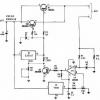.
UC3906 battery charger controller
This UC3906 battery charger circuit controller contains all of the necessary circuitry to control the charge and hold cycle for sealed lead-acid batteries. The UC3906 battery charger circuit is specifically designed to provide the proper charging voltage and current determined by the temperature and state of charge of the battery.
The UC3906 battery charger circuit controller monitor and control both the output voltage and current of the charger through three separate charge states .
UC3906 has separate voltage loop and current limit amplifiers which regulate the output voltage and current levels in the charger by controlling the onboard driver.The charger circuit requires 18 to 22 volts DC input. Three optical ( LED ) indicators show the charge state . This IC is configured to provide three charge states:
Bulk charge – the charger operates in a constant-current charge mode until the battery reaches the programmed full-charge voltage.
Overcharge – when the voltage reaches the programmed full-charge voltage, the charger switches to overcharge mode to ‘top-off’ the battery.
Float charge – when the current decreases to the minimum overcharge current, the charger enters the float charge mode.

- Log in to post comments




Comments
What type of Lead Acid is this designed for?
When voltage is between 10.2